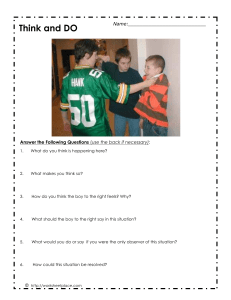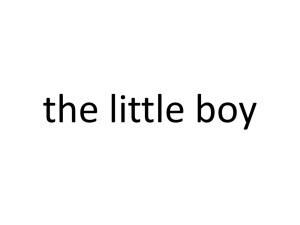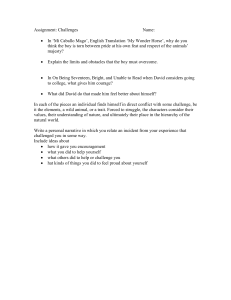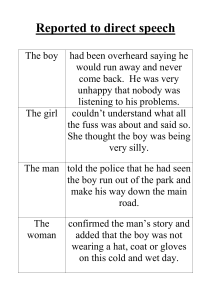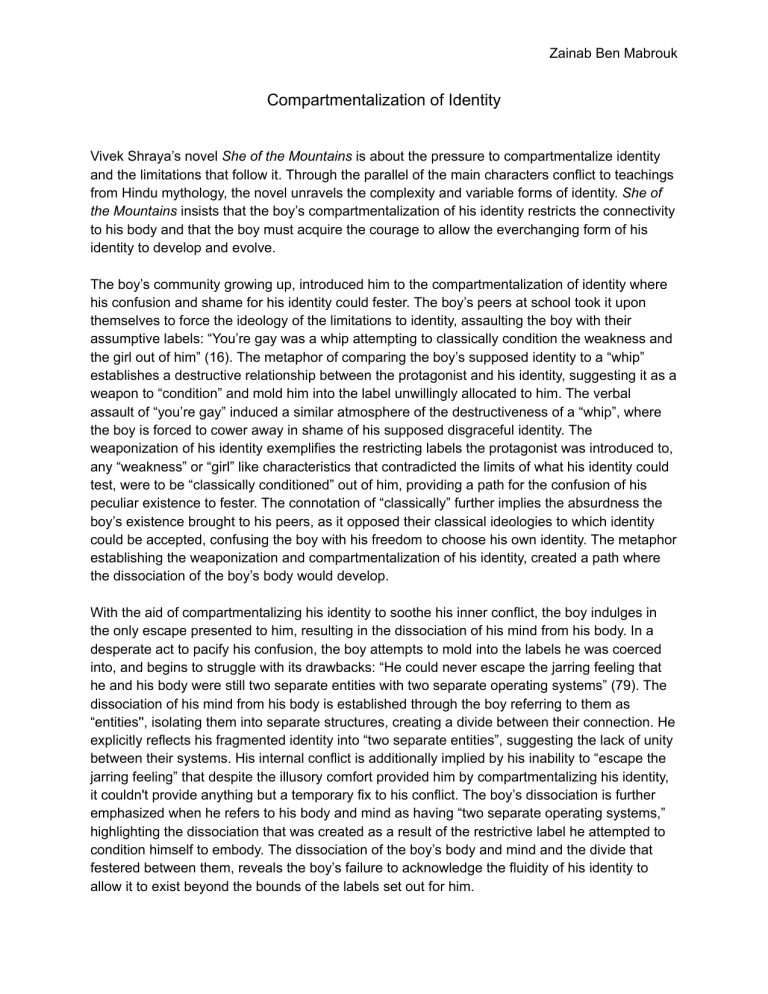
Zainab Ben Mabrouk Compartmentalization of Identity Vivek Shraya’s novel She of the Mountains is about the pressure to compartmentalize identity and the limitations that follow it. Through the parallel of the main characters conflict to teachings from Hindu mythology, the novel unravels the complexity and variable forms of identity. She of the Mountains insists that the boy’s compartmentalization of his identity restricts the connectivity to his body and that the boy must acquire the courage to allow the everchanging form of his identity to develop and evolve. The boy’s community growing up, introduced him to the compartmentalization of identity where his confusion and shame for his identity could fester. The boy’s peers at school took it upon themselves to force the ideology of the limitations to identity, assaulting the boy with their assumptive labels: “You’re gay was a whip attempting to classically condition the weakness and the girl out of him” (16). The metaphor of comparing the boy’s supposed identity to a “whip” establishes a destructive relationship between the protagonist and his identity, suggesting it as a weapon to “condition” and mold him into the label unwillingly allocated to him. The verbal assault of “you’re gay” induced a similar atmosphere of the destructiveness of a “whip”, where the boy is forced to cower away in shame of his supposed disgraceful identity. The weaponization of his identity exemplifies the restricting labels the protagonist was introduced to, any “weakness” or “girl” like characteristics that contradicted the limits of what his identity could test, were to be “classically conditioned” out of him, providing a path for the confusion of his peculiar existence to fester. The connotation of “classically” further implies the absurdness the boy’s existence brought to his peers, as it opposed their classical ideologies to which identity could be accepted, confusing the boy with his freedom to choose his own identity. The metaphor establishing the weaponization and compartmentalization of his identity, created a path where the dissociation of the boy’s body would develop. With the aid of compartmentalizing his identity to soothe his inner conflict, the boy indulges in the only escape presented to him, resulting in the dissociation of his mind from his body. In a desperate act to pacify his confusion, the boy attempts to mold into the labels he was coerced into, and begins to struggle with its drawbacks: “He could never escape the jarring feeling that he and his body were still two separate entities with two separate operating systems” (79). The dissociation of his mind from his body is established through the boy referring to them as “entities'', isolating them into separate structures, creating a divide between their connection. He explicitly reflects his fragmented identity into “two separate entities”, suggesting the lack of unity between their systems. His internal conflict is additionally implied by his inability to “escape the jarring feeling” that despite the illusory comfort provided him by compartmentalizing his identity, it couldn't provide anything but a temporary fix to his conflict. The boy’s dissociation is further emphasized when he refers to his body and mind as having “two separate operating systems,” highlighting the dissociation that was created as a result of the restrictive label he attempted to condition himself to embody. The dissociation of the boy’s body and mind and the divide that festered between them, reveals the boy’s failure to acknowledge the fluidity of his identity to allow it to exist beyond the bounds of the labels set out for him. The harmony and connectivity Ganesh harbors with his unusual body can be applied to alleviate the conflict the boy feels. Despite his elephant head, a beacon for other creatures' confusion, Ganesh is indifferent to his body and identity as a contradictory existence. When told the tale of the origin of his elephant head, and brought to the burial of the head of what he once bore, “Ganesh bends down and put his head down to the fallen leaves and wet earth. Then he begins to sing” (96). The imagery of Ganesh bending down onto the “fallen leaves and wet earth” establishes a close relation to Ganesh and the burial of his past self, a divide between his past and present self encapsulated by the earth, but the acknowledgment of its existence with the motion of him bending down. The action of Ganesh singing further emphasizes his acknowledgment as it creates an atmosphere of acceptance and new life. The song suggests that just as his mother Parvati would sing the same melody as a representation of new life forming, Ganesh sings for the new creation of his identity while acknowledging the conclusion of his past identity. The imagery emphasizing the connectivity of Ganesh to his unique identity established a path that the boy could learn from, the courage to proudly accept the fluidity of his identity that exists past the limitations forced upon him. The boy’s strength and courage to simultaneously accept and relinquish parts of his flourishing identity came in the form of him testing the bounds of what was once shunned, a lesson reflecting Ganesh’s actions. After breaking up with his girlfriend due to his newfound identity, the boy turns to water for comfort, where he could finally develop his identity and let go of past restrictions, “It was only after he exhausted himself from splashing and kicking aimlessly, when he fully surrendered to the water, that he stopped drowning” (99). The challenging path in gaining the courage to confidently express his identity is emphasized through the description “exhausted,” suggesting the toll his internal conflict yielded on his mind. “Splashing and kicking” implies the tiring fight the boy put up to desperately hold on to the only solution he knew to soothe the confusion plaguing him, despite “aimlessly” struggling for only a temporary fix. The boy’s remedy comes in the form of when he finally “surrendered to the water,” relinquishing himself of limitations that restricted the fluidity of his identity, his fragmented identity reconstructing itself into a new form. “Stopped drowning” further establishes the boy’s acceptance as it expresses the conclusion to his struggles, the termination to his aimless suffering. The acceptance and refusal to compartmentalize his identity, supplied the boy with the courage to rid himself of the shame he once harbored, allowing a foundation for a new identity to flourish. Ultimately, She of the Mountains opposes the limitations placed on identity and restriction of its fluidity and that one must find the courage to test the bound of its restriction to allow their identity to evolve. Shraya,Vivek. She of the Mountains. EPUB, Arsenal Pulp Press, 2014

